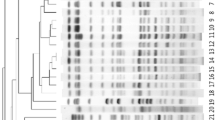Abstract
Background
In the 1,200-bed university hospital “Umberto I” in Rome, Italy, we observed a dramatic substitution of a precedingly well-documented Klebsiella pneumoniae clone (ST37) with ertapenem resistance by outer membrane permeability modification (Porin-ER-Kp) with a new K. pneumoniae strain expressing carbapenem resistance due to K. pneumoniae carbapenemase production (KPC-CR-Kp). A case–case–control study was carried out to evaluate risk factors for Porin-ER-Kp and KPC-CR-Kp isolation.
Methods
All patients with hospital-acquired K. pneumoniae isolation between July 2008 and June 2011 were included. Two case groups including patients harbouring KPC-CR-Kp and Porin-ER-Kp were analysed, with a third control group from whom carbapenem-susceptible K. pneumoniae (CS-Kp) were isolated.
Results
Forty-four KPC-CR-Kp cases, 39 Porin-ER-Kp cases and 60 CS-Kp controls were analysed. During the 3-year study, a specific Porin-ER-Kp endemic clone (ST37) was substituted by a new KPC-CR-Kp clone (ST512). Breakthrough bacteraemias occurred in 21 out of 26 KPC-CR-Kp group bloodstream infections (BSIs); nine of these developed during carbapenem therapy and seven with colistin and/or tigecycline therapy. In 13 Porin-ER-Kp BSIs, breakthrough bacteraemias developed in eight patients and four during carbapenem therapy. In the multivariable analysis, KPC-CR-Kp isolates were associated with carbapenems [odds ratio (OR) 7.74; 95 % confidence interval (CI) 1.70–35.2; p < 0.01) and endoscopy (OR 6.71; 95 % CI 1.25–36.0; p < 0.03). Porin-ER-Kp independent risk factors included second-generation cephalosporins (OR 25.7; 95 % CI 3.20–206.8; p < 0.01), carbapenems (OR 19.1; 95 % CI 4.34–83.9; p < 0.001), acute renal failure (OR 7.17; 95 % CI 1.33–38.6; p < 0.03), endoscopy (OR 6.12; 95 % CI 1.46–25.6; p < 0.02) and third-generation cephalosporins (OR 5.3; 95 % CI 1.34–20.9; p < 0.02).
Conclusions
Porin-ER-Kp strains needed major antimicrobial pressure compared to KPC-CR-Kp to express resistance. KPC-CR-Kp substituted Porin-ER-Kp strains, causing more infections. KPC-CR-Kp breakthrough bacteraemia occurred even under therapy with tigecycline or colistin, underlining that an antibiotic stewardship programme is needed urgently.

Similar content being viewed by others
References
European Antimicrobial Resistance Surveillance System (EARSS). Annual report (2009). http://www.rivm.nl/earss.
Kallen AJ, Hidron AI, Patel J, Srinivasan A. Multidrug resistance among gram-negative pathogens that caused healthcare-associated infections reported to the National Healthcare Safety Network, 2006–2008. Infect Control Hosp Epidemiol. 2010;31:528–31.
Orsi GB, Falcone M, Venditti M. Surveillance and management of multidrug-resistant microorganisms. Expert Rev Anti Infect Ther. 2011;9:653–79.
Nordmann P, Cuzon G, Naas T. The real threat of Klebsiella pneumoniae carbapenemase-producing bacteria. Lancet Infect Dis. 2009;9:228–36.
Elliott E, Brink AJ, van Greune J, et al. In vivo development of ertapenem resistance in a patient with pneumonia caused by Klebsiella pneumoniae with an extended-spectrum beta-lactamase. Clin Infect Dis. 2006;42:e95–8.
Gröbner S, Linke D, Schütz W, et al. Emergence of carbapenem-non-susceptible extended-spectrum beta-lactamase-producing Klebsiella pneumoniae isolates at the university hospital of Tübingen, Germany. J Med Microbiol. 2009;58:912–22.
Leavitt A, Chmelnitsky I, Colodner R, Ofek I, Carmeli Y, Navon-Venezia S. Ertapenem resistance among extended-spectrum-beta-lactamase-producing Klebsiella pneumoniae isolates. J Clin Microbiol. 2009;47:969–74.
Mena A, Plasencia V, García L, et al. Characterization of a large outbreak by CTX-M-1-producing Klebsiella pneumoniae and mechanisms leading to in vivo carbapenem resistance development. J Clin Microbiol. 2006;44:2831–7.
Doménech-Sánchez A, Martínez-Martínez L, Hernández-Allés S, et al. Role of Klebsiella pneumoniae OmpK35 porin in antimicrobial resistance. Antimicrob Agents Chemother. 2003;47:3332–5.
Doumith M, Ellington MJ, Livermore DM, Woodford N. Molecular mechanisms disrupting porin expression in ertapenem-resistant Klebsiella and Enterobacter spp. clinical isolates from the UK. J Antimicrob Chemother. 2009;63:659–67.
Jacoby GA, Mills DM, Chow N. Role of beta-lactamases and porins in resistance to ertapenem and other beta-lactams in Klebsiella pneumoniae. Antimicrob Agents Chemother. 2004;48:3203–6.
Wang XD, Cai JC, Zhou HW, Zhang R, Chen GX. Reduced susceptibility to carbapenems in Klebsiella pneumoniae clinical isolates associated with plasmid-mediated beta-lactamase production and OmpK36 porin deficiency. J Med Microbiol. 2009;58:1196–202.
García-Fernández A, Miriagou V, Papagiannitsis CC, et al. An ertapenem-resistant extended-spectrum-beta-lactamase-producing Klebsiella pneumoniae clone carries a novel OmpK36 porin variant. Antimicrob Agents Chemother. 2010;54:4178–84.
Ben-David D, Kordevani R, Keller N, et al. Outcome of carbapenem resistant Klebsiella pneumoniae bloodstream infections. Clin Microbiol Infect. 2012;18:54–60.
Falagas ME, Rafailidis PI, Kofteridis D, et al. Risk factors of carbapenem-resistant Klebsiella pneumoniae infections: a matched case control study. J Antimicrob Chemother. 2007;60:1124–30.
Gasink LB, Edelstein PH, Lautenbach E, Synnestvedt M, Fishman NO. Risk factors and clinical impact of Klebsiella pneumoniae carbapenemase-producing K. pneumoniae. Infect Control Hosp Epidemiol. 2009;30:1180–5.
Hyle EP, Ferraro MJ, Silver M, Lee H, Hooper DC. Ertapenem-resistant Enterobacteriaceae: risk factors for acquisition and outcomes. Infect Control Hosp Epidemiol. 2010;31:1242–9.
Hussein K, Sprecher H, Mashiach T, Oren I, Kassis I, Finkelstein R. Carbapenem resistance among Klebsiella pneumoniae isolates: risk factors, molecular characteristics, and susceptibility patterns. Infect Control Hosp Epidemiol. 2009;30:666–71.
Mouloudi E, Protonotariou E, Zagorianou A, et al. Bloodstream infections caused by metallo-β-lactamase/Klebsiella pneumoniae carbapenemase-producing K. pneumoniae among intensive care unit patients in Greece: risk factors for infection and impact of type of resistance on outcomes. Infect Control Hosp Epidemiol. 2010;31:1250–6.
Patel G, Huprikar S, Factor SH, Jenkins SG, Calfee DP. Outcomes of carbapenem-resistant Klebsiella pneumoniae infection and the impact of antimicrobial and adjunctive therapies. Infect Control Hosp Epidemiol. 2008;29:1099–106.
Orsi GB, García-Fernández A, Giordano A, et al. Risk factors and clinical significance of ertapenem-resistant Klebsiella pneumoniae in hospitalised patients. J Hosp Infect. 2011;78:54–8.
Garner JS, Jarvis WR, Emori TG, Horan TC, Hughes JM. CDC definitions for nosocomial infections. In: Olmsted RN, editor. APIC infection control and applied epidemiology: principles and practice. St. Louis: Mosby; 1996: p. A1–20.
Bryan CS. Clinical implications of positive blood cultures. Clin Microbiol Rev. 1989;2:329–53.
Tsakris A, Poulou A, Pournaras S, et al. A simple phenotypic method for the differentiation of metallo-beta-lactamases and class A KPC carbapenemases in Enterobacteriaceae clinical isolates. J Antimicrob Chemother. 2010;65:1664–71.
Diancourt L, Passet V, Verhoef J, Grimont PA, Brisse S. Multilocus sequence typing of Klebsiella pneumoniae nosocomial isolates. J Clin Microbiol. 2005;43:4178–82.
Harris AD, Karchmer TB, Carmeli Y, Samore MH. Methodological principles of case–control studies that analyzed risk factors for antibiotic resistance: a systematic review. Clin Infect Dis. 2001;32:1055–61.
Won SY, Munoz-Price LS, Lolans K, Hota B, Weinstein RA, Hayden MK; Centers for Disease Control and Prevention Epicenter Program. Emergence and rapid regional spread of Klebsiella pneumoniae carbapenemase-producing Enterobacteriaceae. Clin Infect Dis. 2011;53:532–40.
Gilbert DN, Moellering RC Jr, Eliopoulos GM, Chambers HF, Saag MS. The Sanford guide to antimicrobial therapy. 39th ed. Sperryville: Antimicrobial Therapy, Inc.; 2009.
Tsai YK, Fung CP, Lin JC, et al. Klebsiella pneumoniae outer membrane porins OmpK35 and OmpK36 play roles in both antimicrobial resistance and virulence. Antimicrob Agents Chemother. 2011;55:1485–93.
Pournaras S, Vrioni G, Neou E, et al. Activity of tigecycline alone and in combination with colistin and meropenem against Klebsiella pneumoniae carbapenemase (KPC)-producing Enterobacteriaceae strains by time–kill assay. Int J Antimicrob Agents. 2011;37:244–7.
Nguyen M, Eschenauer GA, Bryan M, et al. Carbapenem-resistant Klebsiella pneumoniae bacteremia: factors correlated with clinical and microbiologic outcomes. Diagn Microbiol Infect Dis. 2010;67:180–4.
Tumbarello M, Viale P, Viscoli C, et al. Predictors of mortality in bloodstream infections caused by Klebsiella pneumoniae carbapenemase-producing K. pneumoniae: importance of combination therapy. Clin Infect Dis. 2012;55:943–50.
Daikos GL, Petrikkos P, Psichogiou M, et al. Prospective observational study of the impact of VIM-1 metallo-beta-lactamase on the outcome of patients with Klebsiella pneumoniae bloodstream infections. Antimicrob Agents Chemother. 2009;53:1868–73.
Conflict of interest
The authors declare that there is no actual or potential conflict of interest in relation to this article.
Ethical statement
The study was approved by the institutional review board (Department of Infectious Diseases, Sapienza University of Rome). All study participants gave informed written consent.
Author information
Authors and Affiliations
Corresponding author
Rights and permissions
About this article
Cite this article
Orsi, G.B., Bencardino, A., Vena, A. et al. Patient risk factors for outer membrane permeability and KPC-producing carbapenem-resistant Klebsiella pneumoniae isolation: results of a double case–control study. Infection 41, 61–67 (2013). https://doi.org/10.1007/s15010-012-0354-2
Received:
Accepted:
Published:
Issue Date:
DOI: https://doi.org/10.1007/s15010-012-0354-2




